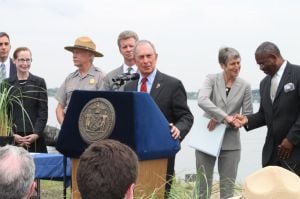Jamaica Bay to be site of CUNY environmental institute
Science and Resilience Institute will focus research on sustainability
City Parks Commissioner Veronica White, left, National Parks Service Director Jonathan Jarvis, U.S. Secretary of Housing and Urban Development Shaun Donovan, Mayor Bloomberg, U.S. Secretary of the Interior Sally Jewell and Rep. Greg Meeks at Monday’s announcement of CUNY’s new Science and Research Institute to be built near Jamaica Bay.
Posted: Wednesday, August 14, 2013 10:30 am | Updated: 8:46 pm, Wed Aug 14, 2013.
Plans are in the works for a state-of-the-art research and learning center dedicated to the environment and sustainability, and the city says the Rockaways will likely play host to the institution.
U.S. Secretary of the Interior Sally Jewell and U.S. Secretary of Housing and Urban Development Shaun Donovan announced the creation of the new Science and Resilience Institute, which will be operated by the City University of New York, at Riis Landing in the Rockaways on Monday morning at a press conference with Mayor Bloomberg, National Parks Director Jonathan Jarvis, City Parks Commissioner Veronica White, Rep. Greg Meeks (D-Jamaica), Acting CUNY Chancellor Bill Kelly and Peter Madonia, chief operating officer of the Rockefeller Foundation, who will be providing some of the funding for the new institution.
As part of the general management plan signed in 2011 between the Department of the Interior — which operates Gateway National Recreation Area, the parkland that includes much of Jamaica Bay — and the city, the new institute will be established first at Brooklyn College, but will move into a facility that is planned as of now to be built in the Rockaways in the coming years.
“The institute will focus its research on protecting and preserving urban ecosystems from development and from the effects of climate change and thereby making urban areas more resilient as well,” Bloomberg said. “The institute will work in partnership with other schools, nonprofit organizations, government partners and city agencies and will serve as a coordinating body for the research fieldwork taking place around Jamaica Bay and providing lab spaces for students and researchers.”
The cost and time frame of the construction of the brick and mortars institute is still unknown, according to Parks Commissioner Veronica White, and a committee is being formed to scout a location and identify the price tag.
For decades, Jamaica Bay was notorious for its pollution and for a time seemed hopeless. But in the past few decades, starting with the creation of Gateway in 1972, the bay has seen a natural renaissance.
Jewell said the institute will serve as a tool for resiliency and sustainable environments nationwide and the once-polluted Jamaica Bay will be at the center of that.
“Connecting the community of New York to these green spaces that are a public transit ride away is going to change lives,” she said. “You just don’t get assets like this close to a population center. It’s going to become a great laboratory. Jamaica Bay is going to be a perfect place for the whole country to learn about resilience and science and how these natural ecosystems combined with man-made ecosystems interact.”
Though CUNY will operate the institute, it will be as leader of a consortium of other institutions of learning and research including Columbia University’s Earth Institute and its Lamont-Doherty Earth Observatory, Cornell University, NASA Goddard Institute for Space Studies, New York Sea Grant, Institute of Marine and Coastal Sciences at Rutgers University, Stevens Institute of Technology, Stony Brook University and the Wildlife Conservation Society.
The city has committed $3 million toward the institute, which is already getting off the ground. Its first undertaking will be a program called “Urban Resilience in an Era of Climate Change: Global Input for Local Solutions,” a symposium that will take place Oct. 17 and 18 at Kingsborough Community College in Brooklyn. The symposium will bring global and local expertise together to examine what urban resilience means and ways to achieve it.
Kelly said the institute will work on a wide variety of research topics.
“The institute that we are here to inaugurate will focus on issues such as water quality, wetlands restoration and climate change to help us improve the resiliency of this remarkable ecosystem,” he said. “We expect that our work will reach beyond our shores.”
For Jamaica Bay’s environmental experts like Don Riepe, northeast chapter president of the American Littoral Society and a Broad Channel resident, news of the institute was met with optimism about the once-forgotten bay’s future.
“It’s a shot in the arm,” Riepe said. “I’m hoping that they can pull it all together and that we can be a part of it. These education and restoration projects are projects we’ve been doing for years.”
The project was in the works even before Hurricane Sandy and Jewell said the storm gave researchers another case study.
“We saw a green infrastructure actually make a difference and we saw a great infrastructure that didn’t work so well,” she said.
Madonia said the Rockefeller Foundation became interested in the project especially in the wake of Sandy.
“New York isn’t alone,” he said. “Of the 25 most densely populated counties in the country, 23 are on coastlines, so New York as a laboratory became very important to us in finding global solutions.”
Dan Mundy Jr. of Jamaica Bay Eco Watchers said he was concerned that Sandy would derail the plans, and is thankful to see the school moving forward despite the storm.
“We want to rebuild in a smarter way,” he said. “We are very encouraged by this.”
Mundy added that key to making the institute work will be transportation.
“The key is going to be the permanent establishment of a ferry to Manhattan,” he said. “We’re going to need to bring people in from the city.”

No comments:
Post a Comment